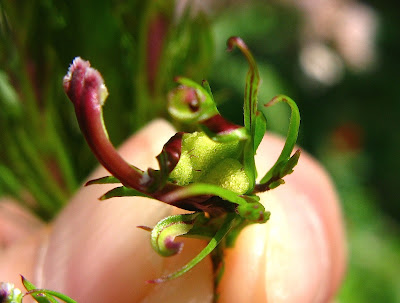
Paddling through golden light along the Hudson banks
Another bright and beautiful day, and lucky me, I had arranged to meet my friend Sue for a paddle on the Hudson this morning. I wanted to show her that Wild Senna I'd found last week (Thanks, Ed!), which was sure to be blooming today. And so it was. Its large cluster of yellow blossoms shining in the sun were hard to miss.
Although this is a Pea Family plant -- and its leaves and seed pods certainly show that family's resemblance -- its flowers don't look very pea-like at all. What funny little pig-snout stamen tubes, positioned to spill their pollen grains on that furry, curving green pistil below.
On our way to the senna's location, we passed this beautiful patch of Narrow-leaved Gentians, their vivid blue flower heads standing out against the leafy green of the bank. Oh dear, is it that time of year already? I always associate gentians with fall, although the narrow-leaved species does bloom a bit earlier than other gentians.
Our next stop was a trio of little islands, where we beached our boats to wander around snacking on Black Huckleberries while we searched the islands for flowers. We had planned on a swim from the rocky shore there, but a brisk breeze and the cool morning air convinced us that wading around in the warm shallow water would be more pleasant. Amid a sea of glowing Golden Pert, these snowy blooms of Grass-leaved Arrowhead stood out.

I had never seen arrowhead blooms with these pink blushes in the center of each petal. I wonder if they turn pink with age as the Large White Trillium does.
The shores of the islands were aglow with clusters of ripening Elderberries and stalks of radiant Cardinal Flower. We stood very still for quite a long time, watching a pair of Ruby Throated Hummingbirds feasting among the Cardinal Flowers, hoping to maybe capture a photo of them. Well, folks, hummingbirds move very fast, so this is the best I could do with my little point-and-shoot camera.
Back on the open water, the wind at our backs, we paddled downstream a ways to where we had found an American Chestnut tree in bloom earlier this summer. Today, the tree was laden with green burry balls.

The chance that any of those husks harbor fertile nuts is very small, since there are no other chestnuts of flowering age in the area to provide the necessary pollen. It's quite unusual to find any chestnuts surviving to this fruit-bearing age before they are killed by the blight that eliminated this tree from American forests.
Our final stop today was to ponder a mystery plant we had found last week: these tall, leafy, many-bracted spikes towering over the surrounding Cardinal Flowers on a muddy shore.
Up closer, we see little purple wormy things emerging from a very bushy stalk.
Here's an even closer view of one of those wormy things.
On some of the blooming tips, I found these lumpy masses made up of minute green spheres.
A very odd plant, indeed! But something about it seemed so familiar. It had a fluted stem and alternate toothed leaves like those of the nearby Cardinal Flowers, and the shape of those little wormy things reminded me of the stamen tubes of those Cardinal Flowers. Here's a photo of those stamen tubes (a bit out of focus, but I think the resemblance can be noted).

So here's what I'm thinking: our mystery plant is a diseased form of Cardinal Flower, stimulated by some kind of infectious agent or genetic mutation to grow into this deformed version. We find similar deformities in the cases of galls and witch's brooms, although in those cases only parts of a plant are affected. This whole plant, consisting of 4 or 5 stalks, exhibits the anomalous structure. But who knows? I asked our state's chief botanist for his opinion, and he suggested that this is a witch's broom of a Cardinal Flower. I guess I'll go with that.
I just hope it's not contagious. The Hudson banks at Moreau are just teeming with Cardinal Flower, and I sure would hate to see them eventually fall prey to whatever has deformed this plant.








1 comment:
Hmmmm...one of life's ponderables. Sounds like a good guess, though.
Post a Comment